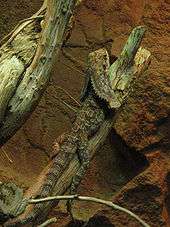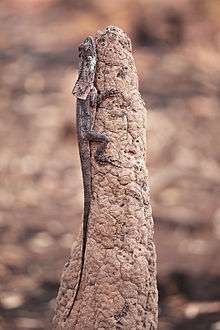Chlamydosaurus
| Chlamydosaurus | |
|---|---|
_(8692622586).jpg) | |
| Scientific classification | |
| Kingdom: | Animalia |
| Phylum: | Chordata |
| Class: | Reptilia |
| Order: | Squamata |
| Suborder: | Iguania |
| Family: | Agamidae |
| Genus: | Chlamydosaurus Gray, 1827 |
| Species: | C. kingii |
| Binomial name | |
| Chlamydosaurus kingii Gray, 1825 | |
| Range map of frilled-necked lizard | |
The frilled-necked lizard (Chlamydosaurus kingii), also known as the frilled lizard, frilled dragon or frilled agama, is a species of lizard which is found mainly in northern Australia and southern New Guinea. This species is the only member of the genus Chlamydosaurus.
Its common name comes from the large frill around its neck, which usually stays folded against the lizard's body. C. kingii is largely arboreal, spending the majority of the time in the trees. The lizard's diet consists mainly of insects and small vertebrates. The frill-necked lizard is a relatively large lizard, averaging 85 cm (2.79 ft) in total length (including tail) and is kept as an exotic pet.
Taxonomy
British zoologist John Edward Gray described the frill-necked lizard in 1825 as Clamydosaurus Kingii, from a specimen collected by an expedition conducted by Captain Phillip Parker King from HMS Mermaid.[1][2][3] King's specimen was obtained by his ship's botanist, Allan Cunningham at Careening Bay off the northwest coast of Australia.[4]
The generic name (Chlamydosaurus) is derived from the Ancient Greek chlamydo (χλαμύς), meaning "cloaked" or "mantled", and saurus (sauros), meaning "lizard". Its specific name is a Latinized form of Phillip Parker King's last name. It is the only member of this genus.[5]
In the Jawoyn language of the Katherine area, it is known as leliyn.[6]
Description

The frill-necked lizard is a relatively large member of the agamid family, growing up to 85 cm (2.79 ft).[7] It is capable of bipedal locomotion and has been described as regularly moving in this manner with a purposeful stride at times by naturalists.[8][9]
Coloration tends to be brown or gray with spots and blotches of darker colors mixed in a mottled fashion to give the appearance of tree bark.[10] There is not one standard colour: rather, colouration varies according to the lizard's environment. For example, a lizard found in a dryer, clay filled environment will most likely have a collage of oranges, reds, and browns; whereas a lizard found in a damper, more tropical region will tend to show darker browns and greys. This suggests they are adapted to their habitats; their colors are a form of camouflage.[11]
The most distinct feature of these lizards is the large ruff of skin which usually lies folded back against its head and neck. The neck frill is supported by long spines of cartilage which are connected to the jaw bones. When the lizard is frightened, it produces a startling deimatic display: it gapes its mouth, exposing a bright pink or yellow lining; it spreads out its frill, displaying bright orange and red scales; raises its body; and sometimes holds its tail above its body.[12] This reaction is used for territorial displays, to discourage predators, and during courtship.[9][13] The red and orange parts of its frill contain carotenoid pigments.[14]
The bones of the frill are modified elongate hyoid types that form rods which expand the frill.[15] Secondarily the frill can serve as a form of camouflage when relaxed; there is no standard coloration to the body, but it is usually darker than the frill.[13]
Distribution and habitat
_camouflaged_within_its_natural_environment.jpg)
The frilled-neck lizard is found mainly in the northern regions of Australia and southern New Guinea.[16] The lizard on rare occasions is found in the lower desert regions of Australia[17] but primarily inhabits humid climates such as those in the tropical savannah woodlands.[18]
It tends to be an arboreal lizard, meaning it spends a majority of its time in the trees.[18] The lizard ventures to the floor only in search of food, or to engage in territorial conflicts.[19] The arboreal habitat may be a product of the lizard's diet, which consists mainly of small arthropods and vertebrates (usually smaller lizards).[19] However, the trees are most importantly used for camouflage.[20]
Diet

Like many lizards, frill-necked lizards are carnivores, feeding on cicadas, beetles, termites, and mice.[21] They especially favor butterflies, moths and their larvae.[22] Though insects are their primary source of food, they also consume spiders and occasionally other lizards.[23] Like most members of the agamids (dragons), frill-necked lizards employ an ambush method of hunting, lying in wait for their prey.[24] When the lizards eat, they eat in abundance; these binge periods usually occur during the wet season, when they ingest hundreds to thousands of alate (flying) ants or termites.[24]
Thermoregulation
The frilled-neck lizard is ectothermic and maintains its body temperature by basking briefly to achieve an average of 2–3 °C above the surrounding temperature.[25] Weather conditions, including sunlight, are the main factors regulating the lizards’ temperature. This basking period usually occurs in the morning to early afternoon to ensure maximum exposure to sunlight. However, the lizard's final internal temperature depends mainly on the ambient temperature of the surrounding environment. The lizard's frill was once thought to aid in thermoregulation, but this has been found without merit.[13][26]
Reproduction and sexual dimorphism

The frilled-neck lizard is sexually dimorphic; meaning that there are physical differences between male and females. This dimorphism is apparent in the length of the lizard; the male is generally larger than the female.[24] There is little to no dimorphism in the color of the lizard.[13]
Frilled-necked lizards breed in the early wet season from September to October.[13] Adult males fight for mates, displaying their frills and biting each other. One to two clutches of 6–25 eggs are laid from early to mid-wet season from November to February.[13] The eggs are laid in a nest 5–20 cm below ground, and usually in sunny areas. Incubation takes two to three months.[19] Gender is partly temperature determined, with extreme temperatures producing exclusively females, and intermediate temperatures (29 to 35 °C) producing equal numbers of males and females. Their eggs are soft-shelled.[24]
Predators
The species' main predators are eagles, owls, larger lizards, snakes, dingoes and quolls.[27]
In culture
A frill-necked lizard was featured on the reverse of the Australian 2-cent coin until 1991.[28] A frill-necked lizard named "Lizzie" was the mascot for the 2000 Summer Paralympic Games.[26] The lizard features on the emblem of the Northern Australian regiment NORFORCE.[29]
Because of its unique appearance and behavior, the creature has often been used in film and television. A frill-necked lizard named "Frank" appeared in the 1990 Disney animated film The Rescuers Down Under.[30] In the 1993 film Jurassic Park, the dinosaur Dilophosaurus was portrayed with a neck frill that raised when attacking,[15] and generated an increase in demand for frill-necked lizards as pets.[31]
References
- ↑ Gray (1825). "A synopsis of the genera of reptiles and Amphibia, with a description of some new species". Annals of Philosophy 2. 10: 193–217 [197].
- ↑ Australian Biological Resources Study (28 May 2014). "Species Chlamydosaurus kingii J.E. Gray, 1825". Australian Faunal Directory. Canberra, Australian Capital Territory: Department of the Environment, Water, Heritage and the Arts, Australian Government. Retrieved 11 May 2015.
- ↑ Beolens B, Watkins M, Grayson M. (2011). The Eponym Dictionary of Reptiles. Baltimore: Johns Hopkins University Press. xiii + 296 pp. ISBN 978-1-4214-0135-5. ("Chlamydosaurus kingi [sic]", p. 141).
- ↑ Kent, William Saville (1897). The naturalist in Australia. Chapman & Hall, limited. pp. 70–73.
- ↑ "Chlamydosaurus kingi". Animal Kingdom. 58 (4): 44. 1955.
- ↑ Jawoyn Association (2015). "Jawoyn is the language of the Katherine area, and of country north and east of Katherine". Katherine, Northern Territory: Jawoyn Association. Retrieved 1 June 2015.
- ↑ Savage, Melissa. "Chlamydosaurus kingii". Animal Diversity Web. Retrieved 2012-09-21.
- ↑ Lydekker, Richard; Kirby, William Forsell; Woodward, Bernard Barham (1897). Natural History. D. Appleton and company. p. 400.
- 1 2 Cogger, Harold G. (1986). Reptiles and Amphibians of Australia. 2 Aquatic Drive Frenchs Forest NSW 2086: Reed Books PTY LTD. p. 238. ISBN 0 7301 0088 X.
- ↑ Bartlett, Patricia; Griswold, Billy; Bartlett, Richard D. (2001). Reptiles, Amphibians, and Invertebrates: An Identification and Care Guide. Barron's Educational Series. p. 73. ISBN 978-0-7641-1650-6.
- ↑ "Creature Features - Licensed Pets". ABC Online Home. ABC. Retrieved 11 June 2010.
- ↑ Cott, Hugh B. (1940). Adaptive Coloration in Animals. London: Methuen. p. 218.
- 1 2 3 4 5 6 Shine, Richard (1 May 1990). "Function and evolution of the frill of the frillneck lizard, Chlamydosaurus kingii (Sauria: Agamidae)". Biological Journal of the Linnean Society. 40 (1): 11–20. doi:10.1111/j.1095-8312.1990.tb00531.x.
- ↑ Hamilton, D.G., Martin, J. W., and Pryke, S.R. (September 2013). "Fiery frills: carotenoid-based coloration predicts contest success in frillneck lizards". Behavioral Ecology. 24 (5): 1138–1149. doi:10.1093/beheco/art041.
- 1 2 Pianka, Eric R.; Vitt, Laurie J. (1 May 2006). Lizards: Windows to the Evolution of Diversity. University of California Press. pp. 145, 269. ISBN 978-0-520-24847-2.
- ↑ Grzimek, Bernhard; Olendorf, Donna (2003). Grzimek's Animal Life Encyclopedia: Reptiles. Gale. p. 216. ISBN 978-0-7876-5783-3.
- ↑ Wagner, Frederic H. (1980). Wildlife of the Deserts. H. N. Abrams. p. 188. ISBN 978-0-8109-1764-4.
- 1 2 Savage, Melissa (2001). "Animal Diversity Web: Chlamydosaurus kingii". University of Michigan Museum of Zoology. Retrieved 17 November 2009.
- 1 2 3 Greer, Allen E. (1989). The biology and evolution of Australian lizards. Surrey Beatty. p. 24. ISBN 978-0-949324-21-4.
- ↑ Shine, R and Lambeck, R (1989). Ecology of Frillneck Lizards, Chlamydosaurus-Kingii (Agamidae), in Tropical Australia. Australian Wildlife Research 16 , 491–500.
- ↑ "Frilled lizard, frill-neck lizard, King's lizard". Retrieved 2009-11-17.
- ↑ "Frill-Necked Lizard". Retrieved 2009-11-19.
- ↑ Bradtke, Birgit. "The Australian Frilled Lizard". Retrieved 2009-11-17.
- 1 2 3 4 Shine, Richard; Robert Lambeck (1989). "Ecology of Frillneck Lizards in Tropical Australia" (PDF). Australian Wildlife. 16: 491–500. Retrieved 2009-11-20.
- ↑ Wilson, Steve (10 October 2012). Australian Lizards: A Natural History. Csiro Publishing. p. 85. ISBN 978-0-643-10642-0.
- 1 2 "Frilled Lizard". Burke's Backyard. CTC Productions. 2000. Retrieved 10 December 2009.
- ↑ "Animal Fact Sheets Frilled Lizard (Chlamydosaurus kingii)". ARAZPA. ARAZPA. 2006. Archived from the original on 2009-10-30. Retrieved 2010-01-06.
- ↑ Bruce, Colin R; Michael, Thomas (11 June 2007). 2008 Standard Catalog of World Coins 1901-2000. Iola, Wisconsin: F+W Media, Inc. p. 119. ISBN 978-0-89689-500-3.
- ↑ "Unit History". Archived from the original on 2011-09-27.
- ↑ Bancroft, Tony (2013). Directing for Animation: Everything You Didn't Learn in Art School. CRC Press. p. 5. ISBN 978-1-136-12654-3.
- ↑ Christy, Bryan (2008). The Lizard King: The True Crimes and Passions of the World's Greatest Reptile Smugglers. New York: Twelve. p. 256. ISBN 978-0-446-58095-3.
Further reading
- Bedford GS. (1995). "Anti-predator tactics from the Frilled Neck Lizard Chlamydosaurus kingii ". Journal of the Victorian Herpetological Society 6 (3): 120-130.
- Harlow PS, Shine R. (1998). "Temperature dependent sex-determination in the frillneck lizard Chlamydosaurus kingii (Agamidae)". Herpetologica 55 (2): 205-212.
- Shine R, Lambeck R. (1989). "Ecology of frillneck lizards, Chlamydosaurus kingii (Agamidae) in tropical Australia". Australian Wildlife Research 16: 491-500.
External links
| Wikimedia Commons has media related to Frill-necked lizard. |
| Wikispecies has information related to Chlamydosaurus kingii |
| Wikisource has the text of a 1920 Encyclopedia Americana article about Frill-necked lizard. |